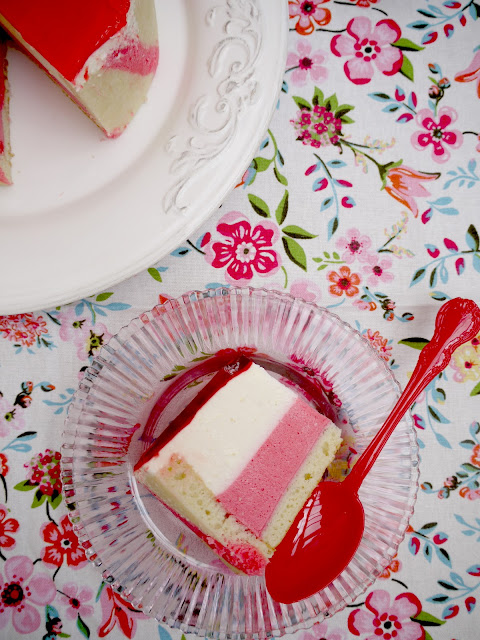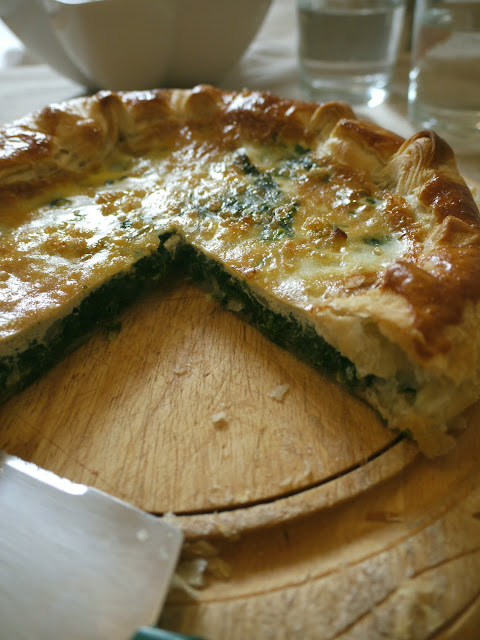The January 2011 Daring Bakers’ challenge was hosted by Astheroshe of the blog accro. She chose to challenge everyone to make a Biscuit Joconde Imprime to wrap around an Entremets dessert.
After a lot of umming and ahhing, I finally decided that I would do this months challenge.
On paper, or screen I suppose, this was the most daunting of all the challenges I've been involved in.
A sponge with a pattern inside? How? What could I do? I settled for a simple pink diagonal line in the end. Not out of laziness (I know that other DBs have done some very intricate patterns.), but more so as to not detract from the eventual beauty of the completed dessert.
There was a lot of room for creativity with this task, both with flavours and design, so I decided on something I've been hankering after for weeks now - Isaphan - Pierre Herme's legendary combination of raspberry, rosewater and lychee.
I filled my joconde imprime with a raspberry-rosewater mousse topped with a lychee mousse.
I had been debating glazing the top too, when the decision was made for me by M.
'Mmmmmmmm.' she exclaimed as ''miss-perpetually-interested-in-the-contents-of-the-fridge'' stuck a finger into the Lychee layer. Although my attempts to re-smooth the layer were successful, the surface lost its shine and I was forced to attempt a Framboise gelee.
It worked.
It improved it.
Hurrah!
Thank you M; I will let you help me with the baking more often in future!

Isaphan Biscuit Joconde Imprime
Joconde Sponge
Ingredients
85g ground almonds
75g confectioners' (icing) sugar85g ground almonds
25g self raising flour
3 large eggs
3 large egg whites
10g white caster sugar
30g unsalted butter, melted
Method
In a clean mixing bowl whip the egg whites and white granulated sugar to firm, glossy peeks. Reserve in a separate clean bowl to use later.
Sift almond flour, confectioner’s sugar, cake flour. (This can be done into your dirty egg white bowl)
On medium speed, add the eggs a little at a time. Mix well after each addition. Mix until smooth and light. (If using a stand mixer use blade attachment. If hand held a whisk attachment is fine, or by hand. )
Fold in one third reserved whipped egg whites to almond mixture to lighten the batter. Fold in remaining whipped egg whites. Do not over mix.
Fold in melted butter.
Reserve batter to be used later.
Patterned Joconde-Décor Paste
Ingredients
50g unsalted butter, softened
50g icing sugar
50g egg whites
55g self raising flour
Christmas red food colouring gel
Method
Cream butter and sugar until light and fluffy (use stand mixer with blade, hand held mixer, or by hand)
Gradually add egg whites. Beat continuously.
Fold in sifted flour.
Tint batter with coloring to desired color.
Preparing the Joconde - How to make the pattern:
Spread a thin even layer of décor paste approximately 1/4 inch (5 millimeter) thick onto silicone baking mat with a spatula, or flat knife. Place mat on an upside down baking sheet. The upside down sheet makes spreading easier with no lip from the pan.
Pattern the décor paste – Here is where you can be creative. Make horizontal /vertical lines (you can use a knife, spatula, cake/pastry comb). Squiggles with your fingers, zig zags, wood grains. Be creative whatever you have at home to make a design can be used.
OR use a piping bag. Pipe letters, or polka dots, or a piped design. If you do not have a piping bag. Fill a ziplock bag and snip off corner for a homemade version of one.
Slide the baking sheet with paste into the freezer. Freeze hard. Approx 15 minutes.
Remove from freezer. Quickly pour the Joconde batter over the design. Spread evenly to completely cover the pattern of the Décor paste.
Bake at gas mark 7 until the joconde bounces back when slightly pressed, approx. 10 minutes. You can bake it as is on the upside down pan. Yes, it is a very quick bake, so watch carefully.
Cool. Do not leave too long, or you will have difficulty removing it from mat.
Flip cooled cake on to a powdered sugared parchment paper. Remove silpat. Cake should be right side up, and pattern showing! (The powdered sugar helps the cake from sticking when cutting.)
Preparing the MOULD for entremets:
Start with a large piece of parchment paper laid on a very flat baking sheet. Then a large piece of cling wrap over the parchment paper. Place a spring form pan ring, with the base removed, over the cling wrap and pull the cling wrap tightly up on the outside of the mold. Line the inside of the ring with a curled piece of parchment paper overlapping top edge by ½ inch. CUT the parchment paper to the TOP OF THE MOLD. It will be easier to smooth the top of the cake.
Preparing the Joconde for Molding:
This is a very good demo of the joconde and filling the entremets:
http://www.youtube.com/watch?v=ca4eLDok-4Q
Trim the cake of any dark crispy edges. Decide how thick you want your “Joconde wrapper”. Traditionally, it is ½ the height of your mold. This is done so more layers of the plated dessert can be shown. However, you can make it the full height.
Once your height is measured, then you can cut the cake into equal strips, of height and length. (Use a very sharp paring knife and ruler.)
Make sure your strips are cut cleanly and ends are cut perfectly straight. Press the cake strips inside of the mold, decorative side facing out. Once wrapped inside the mold, overlap your ends slightly. You want your Joconde to fit very tightly pressed up to the sides of the mold. Then gently push and press the ends to meet together to make a seamless cake. The cake is very flexible so you can push it into place. You can use more than one piece to “wrap “your mold, if one cut piece is not long enough.
The mould is done, and ready to fill.
Raspberry-Rosewater Mousse
Ingredients
200g raspberry puree
200ml double cream
2 1/2 gelatine sheets
50g granulated sugar
2tbsp rosewater
Method
Soak gelatin sheets in cold water until they are soft.
Put the fruit puree, granulated sugar and rosewater into the pan. Cook until it boils and set aside.
Add the gelatin sheets into the pan, mix well and transfer to another bowl. Leave to cool for 10 minutes.
Whip the cream until soft peaks form.
Gently fold in the fruit puree mixture until well combined.
Pour into the mould so it comes halfway up and put it in the fridge at least for 3 hours to set.
Lychee Mousse
Ingredients
150g fresh lychees, peeled and stoned
200ml fresh cream
50g granulated sugar
2 1/2 gelatine sheets
Method
Soak gelatin sheets in cold water until they are soft.
Put the fruit puree and granulated sugar into the pan. Cook until it boils and set aside.
Add the gelatin sheets into the pan, mix well and transfer to another bowl. Leave to cool for 10 minutes.
Whip the cream until soft peaks form.
Gently fold in the fruit puree mixture until well combined.
Pour into the mould so it comes halfway up and put it in the fridge at least for 3 hours to set.
Framboise Gelee
200g raspberry puree
200ml double cream
2 1/2 gelatine sheets
50g granulated sugar
2tbsp rosewater
Method
Soak gelatin sheets in cold water until they are soft.
Put the fruit puree, granulated sugar and rosewater into the pan. Cook until it boils and set aside.
Add the gelatin sheets into the pan, mix well and transfer to another bowl. Leave to cool for 10 minutes.
Whip the cream until soft peaks form.
Gently fold in the fruit puree mixture until well combined.
Pour into the mould so it comes halfway up and put it in the fridge at least for 3 hours to set.
Lychee Mousse
Ingredients
150g fresh lychees, peeled and stoned
200ml fresh cream
50g granulated sugar
2 1/2 gelatine sheets
Method
Soak gelatin sheets in cold water until they are soft.
Put the fruit puree and granulated sugar into the pan. Cook until it boils and set aside.
Add the gelatin sheets into the pan, mix well and transfer to another bowl. Leave to cool for 10 minutes.
Whip the cream until soft peaks form.
Gently fold in the fruit puree mixture until well combined.
Pour into the mould so it comes halfway up and put it in the fridge at least for 3 hours to set.
Framboise Gelee
Ingredients
1tbsp framboise liqueur
1tbsp water
1tbsp caster sugar
1tbsp glucose syrup
1/2 sheet leaf gelatine
Method
Place the sheet of gelatine in a bowl of cold water for five minutes to soften.
Place all of the above ingredients into a small saucepan and heat gently to dissolve the sugar. Add a little red food colouring if you're bot happy with the colour of the gelee.
Remove from the heat and stir in the gelatine leaf to dissolve it.
Leave to cool for ten minutes without settling and finally pour onto the top of the mousse. Return the dessert to the fridge for two hours until the gelee has set.
1tbsp framboise liqueur
1tbsp water
1tbsp caster sugar
1tbsp glucose syrup
1/2 sheet leaf gelatine
Method
Place the sheet of gelatine in a bowl of cold water for five minutes to soften.
Place all of the above ingredients into a small saucepan and heat gently to dissolve the sugar. Add a little red food colouring if you're bot happy with the colour of the gelee.
Remove from the heat and stir in the gelatine leaf to dissolve it.
Leave to cool for ten minutes without settling and finally pour onto the top of the mousse. Return the dessert to the fridge for two hours until the gelee has set.






